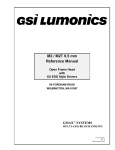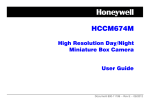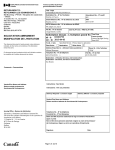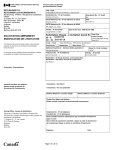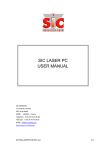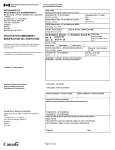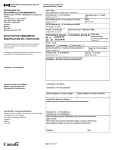Download User Manual HPM10A
Transcript
HPM15VM2 Hardware Manual HPM15VM2 Scan Head 60 Fordham Road Wilmington, MA 01887 TM GMAX SYSTEMS MULTI-AXIS BEAM HANDLING P/N E40-21601 Rev. 1 GSI LUMONICS 1999 GMAX HPM15VM2 Table of Contents TABLE OF CONTENTS 1. INTRODUCTION .......................................................................................................1 1.1 Warranty.............................................................................................................................................. 2 1.2 Customer Support ............................................................................................................................... 3 1.3 Unpacking ........................................................................................................................................... 3 2. HPM15VM2 OVERVIEW ...........................................................................................5 2.1 Theory of Operation............................................................................................................................ 5 2.2 General Description ............................................................................................................................ 6 2.3 Specifications...................................................................................................................................... 7 3. SAFETY AND WARNINGS .......................................................................................9 3.1 Laser Shutter Installation .................................................................................................................. 11 3.2 Installation Safety Requirements ...................................................................................................... 12 4. INSTALLATION .......................................................................................................13 4.1 Handling the XY15VM2 Scan Head Lens........................................................................................ 13 4.2 Mounting the XY15VM2 Scan Head................................................................................................ 14 4.3 HC/2 Card Installation ...................................................................................................................... 15 4.4 Interconnections ................................................................................................................................ 16 5. MAINTENANCE ......................................................................................................17 5.1 Lens / Protection Glass Cleaning...................................................................................................... 17 5.1.1 Introduction....................................................................................................................... 17 5.1.2 Basic Cleaning Procedure ................................................................................................. 17 5.1.2.1 Back-spatter / Burned-in Damage..................................................................... 18 5.2 Mirror ................................................................................................................................................ 18 5.2.1 Cleaning Procedure ........................................................................................................... 18 6. TROUBLESHOOTING ............................................................................................21 7. GLOSSARY .............................................................................................................23 8. APPENDIX A: Specifications ...................................................................................25 8.1 HPM15VM2 Scan Head ................................................................................................................... 25 8.2 HPM15VM2 Scan Head Mirror........................................................................................................ 26 8.3 HPM15VM2 Scan Head Pin Configurations .................................................................................... 27 9. APPENDIX B: Technical Outline Drawings .............................................................29 i GMAX HPM15VM2 1. Introduction High Performance Laser Scanning Module (HPM15VM2) Hardware Manual 1. INTRODUCTION his manual details the instructions on how to install and operate hardware of the High Performance Laser Scanning Module (HPM15VM2). Included is information on setting up the hardware in preparation for your software commands, at which point you can refer to the proper software manual. T Be careful to observe the information in the Environmental Requirements section that alert you to the hazards and the laser beam path you can expect while running the HPM15VM2. Many of the details in this manual refer to the XY15VM2 Scan Head used within the HPM15VM2 module. This is because the XY15VM2 head is extremely intricate, and since it consists of the galvanometers that reflect the laser beam, it can be hazardous if certain precautions are not taken. Please be alert to the safety considerations and specific procedures regarding the XY15VM2 head and the laser you are using. Conventions Throughout the manual you will see graphic icons representing pertinent information in the text. The purpose of these icons is to provide a visual convention to alert you of a stop in the flow of the manual, where an important note or safety hazard alert is posted. NOTE is an important procedure you should be aware of before proceeding. CAUTION alerts you of a potential danger to equipment or the user. WARNING indicates an imminent danger to the user. TIP and REMINDER are helpful hints to procedures listed in the text. The conventions are listed as follows, showing both the text and the picture you will see. NOTE CAUTION TIP WARNING REMINDER GMAX, HC/2, HCI, PC-MARK MT, HPM and HPLK are trademarks of GSI Lumonics. Microsoft, MS-DOS and Windows are registered trademarks of Microsoft Corporation. HP is a registered trademark of Hewlett-Packard Company. 1 GMAX HPM15VM2 1. Introduction 1.1 Warranty GSI Lumonics (GSLI) warrants this product to be free from defects in materials and workmanship for 12 months from the date of shipment. GSLI will, at its option, repair or replace the product if it is defective within the warranty period and returned, freight pre-paid, to a service center designated by GSLI. GSI Lumonics requests that customers obtain a Return Authorization Number prior to returning units, and that they carefully pack units in their original packing or equivalent. Under warranty, GSLI is not obligated to repair damage to any units resulting from the following conditions (customers are responsible for defining which conditions are applicable to their product): a) Personnel other than GSLI representatives attempting to repair or service the product. b) Improper use of the equipment. c) Connecting the product to incompatible equipment. d) Personnel other than GSLI representatives modifying the product. e) Scratches and chips on any optical surface after three weeks from the date of receipt. f) Damage to any optical surface from improper handling or cleaning procedures. This applies specifically to those items subjected to excess laser radiation, contaminated environments, extreme temperature or abrasive cleaning. NOTE 2 Customers assume all responsibility for maintaining a laser-safe working environment. OEM customers must assume all responsibility for CDRH (Center for Devices and Radiological Health) certification. There is no implied warranty of fitness for a particular purpose, and GSLI is not responsible for consequential damages. Individual components manufactured by GSLI or others may be covered by their own warranties. Refer to the appropriate manuals for this information. GMAX HPM15VM2 1. Introduction 1.2 Customer Support GSI Lumonics has support services available to you concerning problems with either the product or manual you are using. Before calling for assistance, please make sure you refer to any appropriate sections in the manual that may answer your questions. The “Technical Outline Drawings” in APPENDIX B may be particularly helpful. If you need further assistance: The customer service personnel will be able to give you direct assistance and answers to your questions. U.S. (Massachusetts): 978-661-4300 (In the U.S.) 01-978-661-4300 (Outside the U.S.) CALL Germany (Munich): +49 89 899134-0 Italy (Monza): +39 39 2025387 UK (Banbury): +44 132-787-2424 Japan (Tokyo): +81 3 3406 7990 ... ask for the GMAX Customer Service Department 1.3 Unpacking A packing list is included in the shipment that details the exact items shipped. a) CAREFULLY unpack the contents from the box. b) Save shipping container and packaging material in case you need to return unit for service. c) Check contents of the box against the packing list to assure all parts have been received. d) Inspect each item to assure it is not damaged. 3 GMAX HPM15VM2 2. HPM15VM2 Overview 2. HPM15VM2 OVERVIEW 2.1 Theory of Operation The High Performance Laser Scanning Module (HPM15VM2) is a multi-purpose-designed module. The module consists of 2 galvanometer scanners (X and Y), optics (flat field lens) and integrated driver electronics all enclosed in a black anodized aluminum case. X and Y Galvanometric Scanners with a Flat Field Lens GSI Lumonics’ 2-mirror, 2-axis galvanometer Scan Heads provide the capability of deflecting optical beams in an XY manner for all possible laser applications. The synchronized actions of two galvanometer servo-controlled turning mirrors direct the laser beam to specific locations on a target material surface in both the X and Y directions. PC-MARK MT and JOB EDITOR (optional), sophisticated laser control software, controls the motion of the galvanometer according to the design selected by the user. The two circuit boards (galvanometer drivers) located in the Scan Head are connected to the computer controller through the HC/2. A 25-pin inter-connecting cable links the drivers to the HC/2. 5 2. HPM15VM2 Overview GMAX HPM15VM2 2.2 General Description The HPM15VM2 is a basic building block for the construction of a laser beam positioning system, It is intended for use by OEM customers, integrators, and sophisticated end-users. It consists of a purposely designed integrated deflection head with a PC based hardware and software package. The following block diagram shows the typical HPM15VM2 system components provided by GSI Lumonics. Block Diagram of a Typical HPM15M2 System GSI Lumonics provides the following items that make up the full HPM15VM2 package: • XY15VM2 Scan Head with 2 galvanometer scanners, optics and integrated driver electronics. • PC-installed HC/2 (I/O-2 add-on control card optional). • 10 ft. digital interface cable. • Software package PC-MARK MT (multitasking), (JOB EDITOR optional). • Documentation. 6 GMAX HPM15VM2 2. HPM15VM2 Overview The Customer must provide: • A laser. • A computer (IBM PC compatible). • A method of mounting the HPM15VM2. • Power Supply with the following specifications: Power Supply Specification s Minimal Computer Requirements Voltage Current Ripple ±15 V to ±18 V 2 A (10 A Peak) Noise ≤ 0.5% DC to 30MHz ≤ 100 mV The minimal configuration for the computer depends on your HC/2. For more information see the appropriate manuals. 2.3 Specifications Environmental Requirements Storage Temperature: -10°C to +60°C Minimum Operation Temperature: +15°C Maximum Operating Temperature: +34°C Humidity: Non-condensing XY15VM2 Scan Head Specifications and Pin Configurations are located in “APPENDIX A: Specifications”. Mirrors Specifications are located in “APPENDIX A: Specifications”. 7 GMAX HPM15VM2 3. Safety and Warnings 3. SAFETY AND WARNINGS T he United States Food and Drug Administration, through the Center for Devices and Radiological Health (CDRH), has promulgated regulations (21 CFR parts 1000 and 1040) controlling the safety of lasers and laser products for sale or manufacture in the United States. GSI Lumonics’ XY Scan Heads are regulated by the CDRH. This section is a guide to the specific areas of this product and to the manual(s). Pay particular attention to CDRH compliance information. User Responsibilit ies GSI Lumonics’ XY Scan Heads are designed to provide maximum flexibility and ease of use. Such a design inherently requires the user to assure the overall safety of the configuration in use. It is the user's responsibility to insure that: 1) Only lasers certified to comply to CDRH regulations are used with GSI Lumonics’ XY Scan Heads. 2) Certified lasers contain features to assist in their safe usage. These protective features and the protective features within the GSI Lumonics XY Scan Head should not be defeated. CAUTION Laser Hazard Analysis Prior to operating any configuration of the GSI Lumonics XY Scan Heads, you must make a through analysis of system safety. Key information for this purpose is contained in this manual. You would thoroughly familiarize yourself with all this information before proceeding. A full description of laser hazard analysis is beyond the scope of this manual. A good technical survey of laser safety requirements can be found in ANSI Z136.1, “American National Standard For the Safe Use of Lasers”. This is available from: American National Standards Institute, Inc. 1430 Broadway New York, New York 10018 Among the many other sources of laser safety information, the following institution offers several excellent publications.: The Laser Institute of America 5151 Monroe Street, Suite 118W Toledo, Ohio 43623 Final analysis of all safety features should be made by your Laser Safety Officer or a competent specialist in this field. The first consideration in a safety analysis is the laser mated to the GSI Lumonics XY Scan Head. The hazard level of the laser is roughly indicated by the Laser Class label that is on the device. A brief description of the radiation classes are shown in the following table. Note that, besides radiation, lasers may present other hazards, e.g.; electric shock or creation of poisonous fumes. Classes and Characteristi cs of Lasers 9 GMAX HPM15VM2 3. Safety and Warnings LASER CLASS DESCRIPTION Class I Lasers are not considered to be hazardous. Class IIa Lasers are hazardous if viewed for periods greater than one thousand seconds. Class II Lasers are chronic viewing hazards. Class IIIa Lasers may represent acute, intrabeam viewing or chronic or acute viewing hazards when viewed with optical instruments. Class IIIb Lasers are an acute hazard to skin and eyes from direct radiation. Class IV Lasers are an acute hazard to skin and eyes from direct or scattered radiation. Do not use equipment outside of these ranges, as additional hazards may result. CAUTION Because we do not determine the laser used with our product, all GSI Lumonics end-user XY Scan Heads are labeled at the highest hazard level (Class IV). You should obtain information on output power or energy, wavelength(s) of output, duration of pulse, beam size and beam divergence from the manufacturer of the laser you are using. The wavelength and power of the laser actually used should be written on the warning logo type label, Position 2. (See Section page 33699 and 33700 of the Federal Register, Appendix B). Be sure to use a permanent, indelible ink. Class IV Warning Label REMINDER 10 The Federal Register Rules and Regulations, Vol. 50, No. 161, dated Tuesday, August 20, 1985, contains the performance standards adopted by the Food and Drug Administration (FDA) which gives detailed information regarding the determination of laser classification and labeling. The ANSI and the FDA classifications are not the same. For purposes of labeling, use only the FDA classifications. If your laser falls in a classification below Class 4, replace the warning label type with the correct label and appropriate classification. The factory provides alternate labels upon request. The GSI Lumonics XY Scan Heads provide you with the ability to aim the laser beam over a roughly pyramidal volume. The divergence of the focused beam beyond the focal point, which is a function of the lenses selected and their position, can cause radiation to exit the pyramid. When analyzing safety, you must consider all regions within this aiming pyramid, the divergent beam, and the effects of all focal possibilities in the zone of hazard. Reflections must also be considered. GMAX HPM15VM2 3. Safety and Warnings 3.1 Laser Shutter Installation The laser attenuator (shutter) is not included with the XY Scan Head. Because each laser is unique, it is the user's responsibility to insure that such a device is incorporated in the installation in conformance with CFR regulations (1040.10[f][6]), which reads as follows: REMINDER A beam attenuator is required on Class II, IIIa, IIIb and IV laser systems. The beam attenuator is a mechanical or electrical device such as a shutter or attenuator that blocks emission. The beam attenuator blocks bodily access to laser radiation above Class I limits without the need to turn off the laser. The beam attenuator must be available for use at all times during operation. Power switches and key controls do not satisfy the attenuator requirement. Laser Shutter Location Example in a HPLK System input dia Laser M2 M1 Turning Mirrors Shutter Loacation focus travel Dynamic Expander Lens Objecitve MX MY Scan Mirrors Target Plane The beam shutter should be installed between the laser head and the Scan Head. The following figure shows the recommended location of the shutter. NOTE Laser Scanner Hazard Zones of an HPM Scan Head We strongly recommend that you specify a laser with a vendorsupplied shutter mechanism. If this is not possible, consult the laser vendor to design a proper safety shutter. The figure shows the laser's internal and external optical path towards the target plane, specifically where the hazard zones are located as the optical beam passes through as HPM Scan Head. 11 3. Safety and Warnings GMAX HPM15VM2 3.2 Installation Safety Requirements Because of the possible hazard increase of scanning stopping or slowing to an unsafe velocity, it is required that the controller software shuts down the laser power (a scanning safeguard). In all cases, we recommend that you fully enclose and interlock the zone of hazard for your application to prevent possible opening while the laser is energized. When laser radiation exceeding Class 1 levels may exit the enclosure, you must have suitable protection for eyes available. NOTE At no time should you stare into the beam, place any parts of your body in the beam path, or expose yourself to reflections of powerful beams. You should use only a Class 1 HeNe Laser for alignment. If this is not possible, you should use the available laser's lowest power setting and remote beam sensing technique. Using optical instruments with this product increases eye hazard. CAUTION Additional Safety requirements may be applicable during initial alignment of the optical system. Refer to Section, “Safety and Warnings”, Section 3. GSI Lumonics XY Scan Heads are labeled in conformance to the requirements of 21 CFR parts 1000 and 1040. 12 GMAX HPM15VM2 4. Installation 4. INSTALLATION Installation Safety Requirements WARNING W e recommend that you fully enclose and interlock the zone of hazard for your application to prevent possible opening while the laser is energized. If laser radiation exceeding Class 1 levels may exit the enclosure, you must have available suitable protection for your eyes. At no time should you stare into the beam, place any parts of your body in the beam path, or expose yourself to reflections of powerful beams. You should use only a class I HeNe laser for alignment. If this is not possible, you should use the available laser’s lowest power setting and remote beam sensing technique. Using optical instruments with this product increases eye hazard. Additional Safety requirements may be applicable during initial alignment of the optical system. See the next section for specific safety information. GSI Lumonics XY15VM2 Scan Heads are labeled in conformance to the requirements of 21 CFR parts 1000 and 1040. 4.1 Handling the HPM15M2 Scan Head Lens If you have not purchased a lens with your HPM15VM2, and you are installing your own lens, or you are removing a lens, follow the steps outlined below for handling and installing a lens. . Lens Mounting YAG Lens Example (Complete Assembly) Cut out Objective including Lens Protection Glass Mounting Ring Protection Cap Make sure that the laser is off before performing any inspections! Wear finger cots or cotton gloves when handling optics for inspection. CAUTION 13 GMAX HPM15VM2 4. Installation To Install a Lens: 1) Before installing a lens onto the Scan Head, visually inspect the lens surface for any evidence of damage, i.e.; cracked lens, cracks on the edges of the lens, scratches on the lens surface. 2) If the lens is dirty, clean the lens per the lens cleaning instructions in the MAINTENANCE. Do not rest any objects on top of the lens as this may result in damaging the lens. 3) If there is a protection glass, make sure it is clean, then place it over the front of the lens. Screw the Mounting Ring into the lens flange until it is tight over the Protection Glass. Hand-fit lens protection cap onto the lens assembly. 4) The lens assembly is screwed into the Scan Head. Carefully and securely mount the lens to the HPM15VM2 Scan Head. (DON’T CROSS-THREAD THE LENS ASSEMBLY). The lens should be screwed on completely. To Remove a Lens: Reverse the above procedure. 4.2 Mounting the HPM15VM2 Scan Head Scan Head Outline 14 GMAX HPM15VM2 XY10VM2 Mounting 4. Installation 1) The Scan Head requires a mounting flange that will match the mounting pins and holes on the Beam Input side of the assembly. The previous figure and the outline drawings, in Appendix C, can be used to determine the dimensions for manufacturing a mounting flange. 2) Line up the HPM15VM2 Scan Head module dowel holes with the dowel pins which protrude from your mounting flange. 3) Install the HPM15VM2 Scan Head module onto the pins. 4) Insert two M6 size buttonhead screws into the holes of the mounting flange. The screw length should be long enough to provide three or more full turns into the tapped holes. 5) Using an allen wrench, tighten the two screws. Alternate tightening the two screws so that the HPM15VM2 Scan Head comes together evenly with the mounting flange. 4.3 HC/2 Card Installation The purpose of the HC/2 is to provide a hardware link between the CPU and the HPM15VM2. Both are cards designed to be installed into a PC type computer. For more information and installation procedure refer to the relevant manual. 15 GMAX HPM15VM2 4. Installation 4.4 Interconnections The following figure depicts the connection of the HPM15VM2 Scan Head and the HC/2 to the various other Customer-supplied parts of the system. HPM15VM2 Connected to a System This completes the installation of the HPM15VM2 system. Install your software onto the computer. Refer to the software manuals for software installation. 16 GMAX HPM15VM2 5. Maintenance 5. MAINTENANCE Cleaning the HPM15VM2 Scan Head T he HPM15VM2 Scan Head assembly is sealed. The housing can be cleaned with a slightly dampened cloth. If a cleaning agent is necessary, use only a small quantity of non-aggressive cleanser (e.g. soap). 5.1 Lens / Protection Glass Cleaning Cleaning the Lens / Protection Glass Special care should be exercised in cleaning a lens that does not have a protection window 5.1.1 Introduction Optical materials and coatings are relatively soft materials and incorrect cleaning techniques can lead to surface damage and drastically reduced component lifetime. Surface contamination can be of different kinds: • Dust, grease and other air-borne particles. • Products from the laser process - back spatter or burned-in particles. • Organic contamination caused by talking, coughing or sneezing near the exposed optical surface. The primary goal is to avoid any contamination by appropriate protection of the exposed optics! The basic cleaning technique described here is intended to help prolong the component lifetime by minimizing surface damage during the cleaning process. Not following this technique can cause severe damage to the optical components. CAUTION 5.1.2 Basic Cleaning Procedure Optical components should always be handled using suitable gloves, or finger-cots, in order to avoid finger prints. TIP 1. Surface dust and loose particles must be blown form the component using an air bulb, ideally one with a non-return valve. 2. Always use cloth or cotton buds which are moistened with pure acetone. Never use cleaning materials which are dry. 3. Use a soft, lint-free lens cloth. The cloth has to be moistened with pure acetone, laid gently on one edge of the component and drawn in a continuous movement to the opposite edge. DO NOT APPLY PRESSURE. DO NOT RUB! 17 GMAX HPM15VM2 5. Maintenance Rubbing may cause permanent surface marks. CAUTION 4. Blow away residue liquid in one direction with an air bulb. 5. Make sure that no visual contaminants remain on the optical surface. 6. Stubborn stuck-on particles may require an attempt to dislodge them by the local application of a cotton bud moistened with pure acetone. 7. Finish off per (3) above. 8. Organic contamination cannot usually be removed using solvents such as acetone. The residue should be removed using distilled water and a lens cloth prior to finishing per (3) above. 5.1.2.1 Back-spatter / Burned-in Damage Some forms of back-spatter can be reduced or removed using the basic cleaning process. In general, however, metallic back-spatter or laser-burned-in damage cannot be removed by cleaning. If the extent of the contamination is sufficient to cause process problems (e.g.: thermal lensing), then consideration should be given to replacement of the contaminated component. 5.2 Mirror Never touch the coating of the mirror to avoid any damages on the surface. CAUTION There are times, however, when cleaning the mirror becomes a necessity. Follow exactly the next section "Cleaning Procedure". 5.2.1 Cleaning Procedure Although the mirrors can be replaced by the user, we do not recommend you do so. Furthermore, GSI Lumonics does not recommend cleaning front surface mirrors. Mirrors damaged by cleaning are not included under the warranty. The surface of these mirrors damages easily. It is difficult to prevent hard dust particles from being entrained in the process and causing scratches. In many cases, small defects in the mirror's surface may less harmful than the surface damage resulting from continued cleaning. It requires special equipment typically not available to customers. There are times, however, when cleaning the mirror becomes a necessity, e.g. stains such as fingerprints must be removed immediately to prevent permanent etching of the reflective surface. The information below includes general recommendations for those special occasions when mirrors must be cleaned. Removing Dust 18 Remove lint from mirrors with a jet of low pressure clean air. Blowing on front surface mirrors deposits moisture that may stain the finish. GMAX HPM15VM2 Removing Stains 5. Maintenance A thin overcoating of silicon monoxide protects most mirrors from oxidation. Like many optical coatings, it is easily damaged when attempts are made to clean the mirror surface with a dry tissue. The safest method of cleaning is to place a piece of lens tissue on the mirror surface and wet it with reagent grade (highly pure) alcohol or acetone (If you use acetone, take precautions regarding possible health and fire hazards). Grasp an overhanging corner of the tissue and gently agitate it several times, then slide the tissue off. This should remove the problem blemishes. Do not let solvent enter the bounding zone of the mirror. CAUTION Note that the mirror is not rubbed. NOTE If the mirror surface is still contaminated, use a highly pure solvent such as alcohol or acetone and generously wet the mirror surface with a sterile cotton swab or lens tissue. Gently wipe the dirty areas. Turn your cotton swab or tissue with each stroke so that a clean area is exposed. Do not let solvent enter the scanner bearings. When wetting the mirror's surface, hold the scanner at an angle so that the liquid does not wet the scanner. If any solvent is found in the bearings of the scanner, the warranty is voided. CAUTION 19 GMAX HPM15VM2 6. Troubleshooting 6. TROUBLESHOOTING I f you encounter problems with your HPM15VM2, you can check the following matrix. If you cannot solve the problem, contact GSI Lumonics for further assistance. PROBLEM 1. 2. Decrease in marking quality. Laser will not mark when ordered by computer. PROBABLE CAUSE POSSIBLE SOLUTION 1. Dirty protection glass. 1. Clean glass per instructions in Maintenance Section. 2. Marking parameters changed. Check PC-MARK MT and JOB EDITOR parameters. 3. Drop in output power. 1. Check laser power. 1. Laser modulation malfunction. 1. Check connections between HC/2 and laser controller. 2. Check connections between laser controller and laser. 1. 2. No power to galvanometers. 1. Check power connections to scanning head. 3. HC/2 malfunction. 1. Verify that HC/2 connections and installation are correct. 21 GMAX HPM15VM2 7. Glossary 7. GLOSSARY Flat Field Lens: Galvanometer: A wavelength specific lens focuses the laser to a small spot and maintains this spot size over the entire target field. A scanner with limited rotation magnetic torque motor with position feedback. The galvanometer (galvo) rotates a mirror to direct the laser beam. HC/2: A PC based board that provides the hardware link between your PC and the XY Industrial Scan Head. I/O for laser control and parts handling are additional features. The HC/2 is fully compatible with PC-MARM MT (multitasking) software. HPGL: HP Graphics Language, a graphics format which PC-MARK MT can translate into vector data for scanning. HPM: (High Performance Modules) Complete beam position packages consisting of the XY Industrial Scan Head, PC resident HC/2 card, PC-MARK MT software and interconnects. I/O-2: An add-on board available as an option to the HC/2 card. Features include opto-isolated programmable I/O ports, analog laser power control and first pulse suppression. PC-MARK MT: (multitasking) A powerful front-end macro command language. PC-MARK MT accepts application commands to place text and graphics in the marking field and translates them into the appropriate lists of vectors. Users may also write their own PC-MARK MT programs in any one of many popular software languages. MMCL is utilized as the link to the HC/2 card. JOB EDITOR: A menu-driven application program of PC-MARK MT that provides an extensive graphics user interface and file management. It allows the user to manipulate HPGL based graphics with an accurate real preview of one’s job. 23 GMAX HPM15VM2 8. APPENDIX A: Specifications 8. APPENDIX A: Specifications 8.1 HPM15VM2 Scan Head Laser Type YAG Wavelength CO2 1,064 nm 1,064 nm 1,064 nm 10,600 nm 10,600 nm Objective (f in mm) f = 100 f = 163 f = 254 f = 200 f = 200HP Standard Field Size (mm²) 33 x 33 120 x 120 180x180 140 x 140 140 x 140 Maximum Practical Field Size (mm²) 1 73 x 73 120 x 120 185 x 185 140 x 140 140 x 140 ~16 ~22 ~33 ~300 ~200 117 210 348 180 204 <4 <7 < 11 <8 <8 > 1.5 > 2.5 > 3.8 > 3.0 > 3.0 ±0.16 ±0.16 ±0.16 ±0.56 ±0.56 8.8 15.0 22.0 17.0 17.0 Spot Size TEM00 (µm) Working Distance (mm) 2 Resolution (µm) 3 Writing Speed (m/s) 4 Uncalibrated Non-Linearity (maximum %) 5 Temperature Drift (maximum µm/°°C) 6 Aperture (mm) 15.0 15.0 15.0 15.0 15.0 Scan Angle (maximum) ±20° ±20° ±20° ±20° ±20° Power Capability, cw (W/cm²) 500 500 500 500 500 Power Capability, 100 ns pulsed (MW/cm²) 100 100 100 400 400 Protection Glass yes yes yes none none black anodized black anodized black anodized black anodized black anodized Scan Head Size (height x length x with in mm) Weight (kg) Surface Finish 1 2 Some beam clipping can occur Distance between edge of head and working field 3 Better than 2 bit in a 16-bit system (±0.003 %) Actual writing speed depends on accuracy and feature sizes (jump speeds can be much higher) 5 Includes lens distortion; non-linearity can be improved by an order of magnitude by using individual calibration methods in software 6 Temperature drift is maximum 0.012 %/°C Non-lens mirror configuration options: Argon, Argon (HP), UV and Visible 4 25 GMAX HPM15VM2 8. APPENDIX A: Specifications 8.2 HPM15VM2 Scan Head Mirror LASER TYPE YAG CO2 ARGON ARGON (HP) UV VISIBLE Wavelength 1,064 nm 10,600 nm 488-514 nm 488-514 nm 325-360 nm 450-700 nm Coating Dielectric Dielectric on Metal Dielectric Dielectric Dielectric Durable Ag Reflection (min.) @ Wavelength (nm) 99.5% @ 1,064 99.5% 98.0% @ 480-514 99.5% 98.0% @ 325-350 96.0% 80.0% @ 450-650 50.0% @ 633 95.0% @ 350-360 45.0% @ 633 Flatness @ 633 nm λ/4 λ/4 λ/4 λ/4 Power Capability, cw (W/cm²) 500 500 100 5 MW/cm² 10 Power Capability, 100 ns pulsed (MW/cm²) 100 400 80 2 GW/cm² (10 ns pulsed) N/A 40/20 40/20 40/20 40/20 Surface Quality (Scratch/Dig) See your GSI Lumonics sales representative for more details. 26 λ/4 40/20 λ/4 40/20 GMAX HPM15VM2 8. APPENDIX A: Specifications 8.3 HPM15VM2 Scan Head Pin Configurations INTERFACE PIN 1 14 13 25 25 Pin D-Sub female connector for HC/2 INTERFACE 5 1 1 14 2 15 3 16 4 17 5 18 6 19 7 20 8 21 9 22 10 23 11 24 12 25 13 ASSIGNMENT SENDCK SENDCK + SYNC SYNC + CHANNEL X CHANNEL X + CHANNEL Y CHANNEL Y + RESERVED FOR Z AXIS RESERVED FOR Z AXIS STATUS STATUS + NC NC NC NC NC NC NC NC NC NC NC NC NC PIN 9 6 9 Pin D-Sub male connector for power supply 5 9 4 8 3 7 2 6 1 ASSIGNMENT +VSS +VSS +VSS GND GND GND -VSS -VSS -VSS 27 GMAX HPM15VM2 9. APPENDIX B: Technical Outline Drawings 9. APPENDIX B: Technical Outline Drawings This Appendix includes the following outline drawings: DRAWING TITLE DRAWING NUMBER Outline HPM15VM2 ECD-21600 29 GMAX HPM15VM2 Index INDEX —C— Computer Requirements, 7 Customer Support, 3 —F— Federal Register, 10 —M— Maintenance HPM10VM2 Cleaning, 17 Lens Cleaning, 17 Mirror Cleaning, 18 Protection Glass Cleaning, 17 Mirror Cleaning, 18 —G— —P— Glossary, 23 —H— HPM10VM2 Definition, 5 Interconnections, 16 Troubleshooting, 21 Power Supply Specifications, 7 Protection Glass Cleaning, 17 —S— —I— Installation HC/2, 15 Specifications Environmental, 7 Mirrors, 7, 26 Power Supply, 7 Scan Head, 7, 25 —W— —L— Laser Classes, 10 Hazard Zones, 11 Shutter Installation, 11 Shutter Location, 11 Warning Label, 10 Lens Cleaning, 17 Mounting, 13 Warranty, 2 —X— XY10VM2 Lens Mounting, 13 Mirror Specifications, 26 Mounting, 14 Pin Configurations, 27 Specifications, 25 Index-1





































